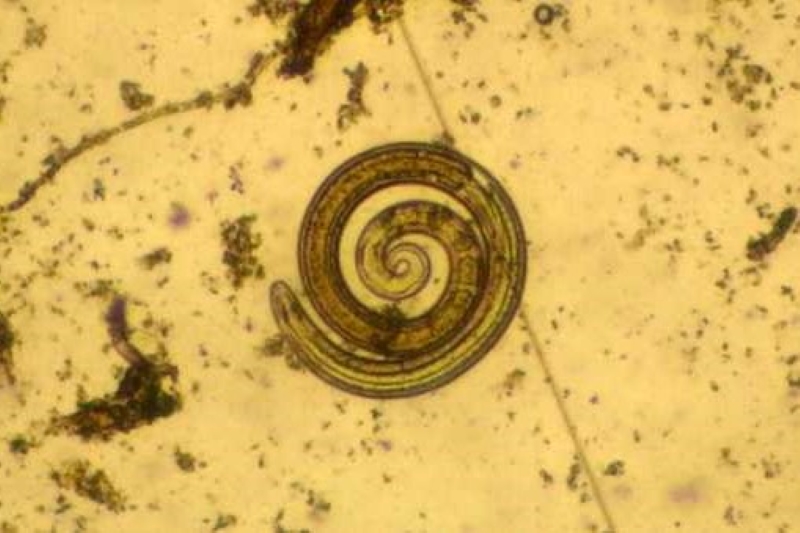
Trichinosis: what it is, symptoms, treatment and how to prevent Trichinella infestation
Trichinosis is an infestation caused by roundworm species belonging to the genus Trichinella
These parasites are capable of infecting mammals, birds and reptiles; the spread in humans is mainly linked to the consumption of meat from the slaughter of infected wild animals, especially wild boar.
What is Trichinella?
The genus Trichinella consists of round nematode worms.
The larvae are about 1 mm long and after being ingested from the stomach migrate to the small intestine, from where they settle in the intestinal epithelium where they develop to the adult stage.
When sexual maturity is reached, around the fourth day after infection, the previously fertilised female produces new larvae that can migrate to the host muscles via the lymphatic circulation.
Within the striated muscles, a new transformation of the parasite takes place, causing the larvae to become nurse cells: in this form, Trichinella can survive even for years, until they are ingested by a new host.
Trichinellosis, how does contagion occur?
The Trichinella species most pathogenic to humans is Trichinella spiralis, which is also adapted to live in domestic and wild pigs; its spread is global.
Native Trichinella and Trichinella britovi are also present in Europe, but they rarely infect pigs.
Human contagion occurs when meat containing nourishing cells is consumed, as it comes from an animal previously infected with Trichinella.
What are the symptoms?
Many Trichinella infestations are mild or even asymptomatic, however, symptoms such as nausea, abdominal pain and diarrhoea may appear within the first week.
Diarrhoea is present in about 40% of those infected.
The incubation period is approximately 8-15 days but may vary from 5 to 45 days.
The clinical picture may become more complex between 1 -2 weeks after encountering the pathogen: facial oedema, myalgia, fever, headaches may appear.
Severe complications the infection may evolve into more severe clinical manifestations, at pulmonary, cardiovascular and neurological levels: arrhythmias, myocarditis, encephalitis, convulsions, pneumonia and pleurisy may appear.
Diagnosis of trichinosis
There are no specific laboratory tests for trichinosis.
Antibodies can be tested for, but are undetectable for the first 2-8 weeks after infection: this can be solved by repeating negative tests at weekly intervals.
The appearance of negative and then positive results may suggest the presence of trichinosis.
Blood tests can be very important as they can highlight the presence of high levels of eosinophilic white blood cells, which are increased in cases of trichinosis.
Diagnosis can be made by studying the patient’s symptoms; a case of trichinellosis can be defined by the presence of at least three of the following symptoms:
- Fever
- Muscle pain
- Diarrhoea
- Facial oedema
- Eosinophilia (increased eosinophilic white blood cells in the blood)
- Subconjunctival haemorrhage
- Proven epidemiological link, i.e. having eaten meat of potentially infected species
Treatment of trichinosis
Treatment is based on the administration of anthelmintic drugs: the action of the drugs, however, is only possible as long as the infection is in the intestinal phase; once the larvae are encysted in the muscles, it is impossible to eradicate them completely with drug treatment.
Symptoms associated with the presence of larvae in the muscles may remain even after anthelmintic therapy has ended.
The most commonly used drug is albendazole: it works by blocking certain biological processes vital to the parasite such as the supply of glucose, which if blocked leads to the death of the trichinella.
Parallel to treatment with anti-parasitic drugs, the doctor may prescribe a supportive therapy based on treating the symptoms; in particular, analgesics may be administered to relieve muscular pain.
For manifestations related to the acute inflammation triggered by the infection, prednisone, a powerful anti-inflammatory drug, is administered.
Prednisone also has the task of stopping cardiac, neurological and pulmonary symptoms related to the inflammatory state.
Prevention of trichinosis
Prevention of trichinosis is very important and can be done by avoiding eating raw or undercooked pork.
A temperature of 65 °C kills the parasite, so it must also be reached inside the meat.
Game must either be inspected by a veterinarian before consumption or tested for trichinella before the animal is slaughtered.
If it is not known whether the meat has been tested for trichinella, it should be frozen for at least 1 month at -15°C: prolonged freezing kills the larvae.
Salting, smoking, cooking in a microwave oven and drying the meat are procedures that do not kill the larvae and should therefore be avoided for prevention purposes.
Read Also
Emergency Live Even More…Live: Download The New Free App Of Your Newspaper For IOS And Android
Hepatic Distomatosis: Transmission And Manifestation Of This Parasitosis
Pulmonary Distomatosis: Symptoms, Diagnosis And Treatment Of Paragonimiasis
Dracunculiasis: Transmission, Diagnosis And Treatment Of ‘Guinea-Worm Disease’
Parasitoses And Zoonoses: Echinococcosis And Cystic Hydatidosis
Toxoplasmosis: What Are The Symptoms And How Transmission Occurs
Toxoplasmosis, The Protozoan Enemy Of Pregnancies
Managing Chickenpox In Children: What To Know And How To Act
Monkeypox Virus: Origin, Symptoms, Treatment And Prevention Of Monkey Pox
Leptospirosis: Transmission, Diagnosis And Treatment Of This Zoonosis
Pityriasis Alba: What It Is, How It Manifests Itself And What Is The Treatment


